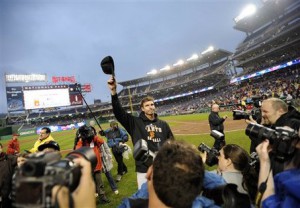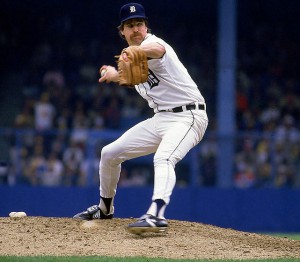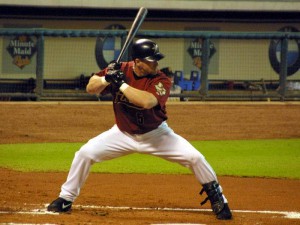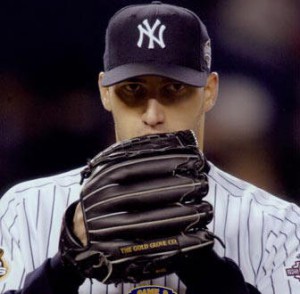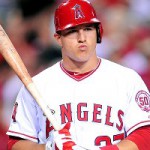
Trout's BABIP was very high in 2012; what does this mean for 2013? Photo Gary Vasquez/US Presswire via espn.com
(Part 2 in a series: Part 1 talked about Whats Wrong with Old School Baseball Stats).
More and more in modern baseball writing, you see relatively new statistical creations thrown into articles in order to prove or disprove an opinion, and more and more you almost need a glossary to properly read these articles and properly understand what the author is attempting to say. I always want to understand that which I read, and at the same time I want to make sure I stay current and up-to-date on the stats out there, so I decided to do a little research (and pen my own post while I was at it) into some of these newer stats that are being used.
I’ll write about each stat, give links to its calculation, write about how it may be used, then put in some rules of thumb by which to consider the stat.
Pretty much every stat here is defined and available at either Baseball-reference.com or fangraphs.com. BaseballProspectus.com also has some more obscure stats discussed further below. I’ve always thought that B-R’s interface was so much easier to navigate that I tend to search there first, but a more complete set of stats is at fangraphs.
1. BABIP. Batting Average on Balls in Play. Most people know this one, but it is an important stat to consider in conjunction with other stats (especially the older Batting Average and Earned Run Average). The calculation, as it is seen at Wikipedia, measures basically how many balls put into play (removing from consideration home runs) turned into hits. Interestingly it penalizes the hitter for hitting sacrifice flies (not sure why). This stat is kept for both individual hitters and for pitchers.
How is BABIP used? The measurement is essentially used as a checkpoint for fluky seasons. If a pitcher has a very high ERA but also has a very high BABIP, one can explain that he’s been unlucky and his talent level lays somewhere below his posted performance on the year. Ironically, the two leaders of Pitcher BABIP in 2012 were both on the Tigers; Rick Porcello and Max Scherzer had BABIPs of .344 and .333 respectively; this delta is probably going to lead to both of these guys having better ERAs in 2013. If a hitter has a decent hitting season but also has a high BABIP, one usually says that the hitter was “lucky” and is due to regress (Mike Trout in 2012 had a Babip of .383. That’s really high, probably unsustainably high, and he probably regresses statistically in 2013).
MLB Average/Rule of thumb: .290-.300 depending on the year.
When BABIP is high: a hitter is considered to be “lucky,” and future regression of more batted balls being turned into outs is expected.
When BABIP is low, a hitter is considered to be “unlucky,” and future improvement of more hits on batted balls is expected.
Caveats using BABIP: there are many arguments about whether some pitchers “baseline BABIP” should be modified based on their talent or capabilites. For example, Mariano Rivera‘s career BABIP is .262 while R.A. Dickey‘s BABIP since he turned into a Mets knuckleballing starter is around .275. Rivera’s lower baseline is probably attributed to his amazing cutter and his pure skill, while Dickey’s is most likely due to the fluctuations of hitting his knuckleball. Meanwhile, some hitters maintain higher than average career BABIPs (two extreme examples that immediately come to mind are Ichiro Suzuki and Nyjer Morgan, with career BABIPs of .347 and .336 respectively. Why so high? Because both are skilled at bunting (or at least hitting choppy grounders) for base hits, artificially inflating their baseline BABIP.
2. ISO; Isolated Power. As posted on Wiki, Isolated power can be simply calculated by subtracting a hitter’s batting average from the slugging percentage, or as it is more eloquently defined at FanGraphs, ISO is essentially a measure of how many extra base hits a batter hits per at-bat. Slugging tells you how many bases per at bat a hitter obtains, but ISO strips out singles to isolate a player’s capability of hitting doubles, triples and homers. Here’s a couple of decent examples from 2012; our own Bryce Harper hits a ton of extra base hits; he’s posted a .206 ISO for the 2012 season. Meanwhile we know that the aforementioned Nyjer Morgan is not a very powerful hitter and ISO shows it; he’s at .069 for the 2012 season. The league leaders for ISO reads like a list of MLB’s best sluggers. Giancarlo Stanton would have led the league in ISO had he qualified; he posted a fantastic .318 ISO in 2012.
How is it used? ISO is used to measure how good a hitter is at getting extra-base hits.
MLB Average/Rule of thumb (from Fangraphs page) .145 is considered an “average” MLB ISO figure. .200 is pretty good, .100 is poor.
Caveats using ISO: as with many sabremetric-tinged stats, small sample sizes greatly skew the figures. Fangraphs says 550 ABs is needed before really drawing any judgements.
3. wOBA; Weighted On Base Average. Created by Tom Tango, wOBA is a relatively newer statistic that attempts to improve upon the traditional batting statistics we use (Batting Average, Slugging and On Base Percentage) by measuring cumulative “weighted” hits that a batter may achieve. It is based on the premise that the three traditional stats just mentioned all treat hitting events relatively the same. Is a single equal to a double? No, but in Batting Average it is. Is a double worth half as much as a home-run? No, but in the Slugging Percentage it is. Each hitting event is weighted and added together, with increases/decreases for stolen bases/caught stealing thrown in, to arrive at a measurement that attempts to better quantify pure hitting.
How is it used? wOBA attempts to be set to the same scale as the league wide OBP, which seems to hover around .315-.320 year to year.
MLB Average/Rule of thumb (from Fangraphs page) .320 is a good “league average” number. .370 is great, .300 is poor.
Caveats using wOBA: There are several to keep in mind; the weights change year to year, in order to normalize the stat across generations. It is NOT normalized to park factors, so hitters in places like Boston and Colorado will have artificially inflated wOBAs to their true value. Lastly, there’s zero context given to the game situation when measuring hits (i.e. was there a guy on third with one out? Was it a close game in the 9th?) I think particular situation is nearly impossible to measure in any stat, but it is important.
4. RC/wRC: Runs Created and Weighted Runs Created. Runs Created is a stat that Bill James invented in one of his earlier Baseball Abstracts (1985) in order to try to measure simply how many runs an individual player contributed to the team in a given season. It was improved upon vastly in 2002 to be much more detailed and accurate; the original version over-emphasized some factors of hitting. It is a complicated statistic (see its wiki page for the formula). The aforementioned Tom Tango improved upon the basic RC by creating the Weighted version of the statistic based on his own Weighted OBA statistic (which he believed more closely measures the proper “value” of each hitting event).
How is it used? Individually, RC and wRC need to be understood in context of an entire season. It isn’t until we get to wRC+ (see below) that a side-by-side comparison is capable. Its like saying “Player X has 105 hits.” If that’s through 75 games, that’s pretty good; if that’s for an entire season, well that’s pretty poor.
MLB Average/Rule of thumb (from Fangraphs page) RC and wRC both have roughly the same scales. 60 is average, 100 is great, 50 is poor for a full season.
Caveats using RC and wRC: They are basically full season counting numbers. In 2012, Trout started in the minors, so his RC and wRC totals are less than his MVP competition Miguel Cabrera.
5. wRC+/wRAA: Weighted Runs Created Plus/Weighted Runs Above Average
wRAA and especially wRC+ are touted by fangraphs.com as being very good “single number” statistics to properly measure a player’s hitting ability. I often use OPS+ as a singular number to measure a hitter; fangraphs specifically calls out this number and recommends using wRC+.
How is it used? Both numbers basically measure the same thing. wRC+ is a bit easier to explain; 100 is the league baseline, and points above or below the average are expressed as “percentage points above or below the league average.” So, a person with a 120 wRC+ is considered to be 20% better at creating runs than the average major leaguer. Cabrera and Trout ironically tied for the MLB lead for 2012 in wRC+, each posting a 166 wRC+. Meanwhile wRAA (per fangraphs.com) “measures the number of offensive runs a player contributes to their team compared to the average player” and is scaled to zero. wRAA is essentially a direct calculation from wOBA, so if you’re using one you can likely ignore the other.
MLB Average/Rule of thumb (from Fangraphs page) for wRC+: 100 is average while for wRAA zero (0) is average. 20-25 percentage points above is great, while 15-20 percentage points below is bad.
Caveats for using: Unlike wOBA, wRC+ is park- and league-adjusted, indeed making it an excellent single number by which to measure players. Otherwise the caveats for these weighted averages are all about the same; they seem to be based on an weighting of hits that you may or may not agree with.
What have I learned from looking into these hitting stats? I need to keep BABIP in mind. I like ISO but I don’t see it gaining real credence over slugging percentage. And I should probably start using wRC+ more than OPS+.
Part 3 coming up on Pitching advanced stats.
